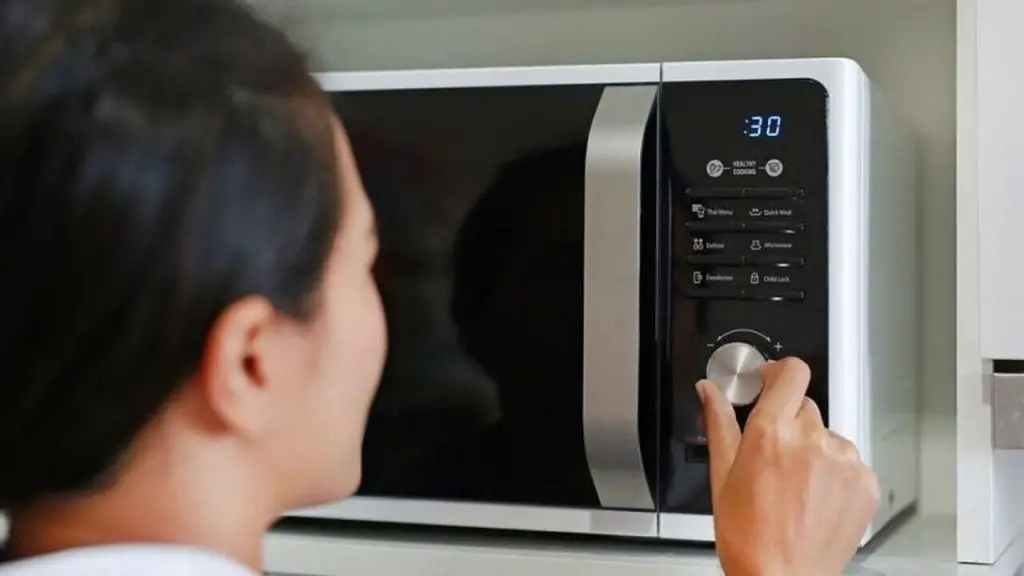We’ll start with the basics – how many watts does a microwave use?
It’s not just an idle question to pass the time – understanding how much energy your appliances consume is important, whether you’re trying to save money on your electric bill or you’re concerned about being more eco-friendly.
In this article, we’ll explore all the factors that go into how microwaves use energy, from how much wattage they need to how standby mode affects electricity consumption.
By the end of it, you’ll be an expert on everything related to microwaves and watts!

The wattage of a microwave oven is usually determined by its size. The typical standard-size microwave, which is most often found on a kitchen countertop, consumes 850 to 1800 watts of electricity.
The usual wattage for the average contemporary microwave is 1200 watts. The correct number will vary depending on the type and brand of microwave installed.
How to Calculate Microwave’s Input Wattage?
To find your microwave’s input wattage i.e., power consumption:
- Check the input power of your microwave’s back plate (i.e. the maximum wattage that the device can utilize). This will be greater than the output power, which is also shown in watts.
- Look for the input wattage figure, rather than the output power figure, in the owner’s instruction manual.
- Visit the manufacturer’s website to find out what the wattage is for your microwave. Many internet resources don’t make it easy to provide the input wattage. To discover how much energy a product uses, look up the owner’s manual online and then search within it.
- The input wattage is calculated by adding the output wattage. Microwaves convert on average 71.29 percent of their input power into cooking power. So if you already know your microwave’s output wattage, you can compute the input wattage yourself or just utilize the Microwave Power Consumption Calculator on the internet. However, it’s possible that your microwave is more or less efficient than normal. The following step is one of the most effective methods for determining your microwave’s actual consumption.
- When the microwave is on, use a multimeter or an energy monitor to determine how many watts it consumes. The KASA smart plug, for example, includes an energy monitor function that may be beneficial.
Because it provides you an idea of the impact your microwave is having on your power expenses and carbon footprint, knowing the input wattage is critical.
Energy Efficiency of a Microwave
Microwaves are approximately 71.29 percent efficient in converting input power to output power, on average. In some cases, contemporary countertop microwave efficiency can be as low as 54%, but it can also reach 93%.
Inverter microwaves are more energy-efficient than traditional ones. The most significant distinction is that inverter microwave ovens have greater control over the magnetron thanks to an inverter instead of a transformer.
This allows for more precise power management, resulting in more efficient heating.
Microwaves are the most efficient cooking equipment available. Despite this, there are occasions when traditional cookware is more energy-efficient.
Microwaves are more energy-efficient since they cook from the inside out. As a result of this, microwaves produce less heat and waste energy in comparison to traditional cooking equipment.
Convection ovens and conventional cookers heat the surrounding air around the dish before cooking from the outside in. This is a more time-consuming and inefficient way of preparing food.
Factors Affecting Energy Cost
Unless you have a big microwave that consumes up to 3000 watts of electricity, your overall energy costs will rarely exceed a few dollars, if at all.
“How many watts does a microwave uses or consume” while cooking and the precise amount it costs you each year is determined by a few key factors:
- Your microwave’s wattage. Compact microwaves, which start at 500 watts and go all the way up to several thousands of watts, are significantly less expensive than their commercial counterparts.
- How often do you use your microwave? Microwaves, on the other hand, require considerably less standby power since most of their energy is spent in the cooking process. The more meals you prepare, the higher your microwave expense will be.
- The power settings you use. When you’re using your microwave at full power, it will use very close to the stated wattage. However, most microwaves include settings that let you utilize a portion of the maximum capacity. When you utilize adjustments such as “melt” or “defrost,” your overall energy consumption will be somewhat lower.
With this in mind, a microwave rated for 1,000 watts will use about .02 kWh per minute (taking into account the typical national electricity rate per kilowatt-hour).
This microwave would cost you roughly 73 cents in cooking power if you used it one minute each day for a year.
Electricity Consumption on Standby Mode
However, if you are a particularly mindful energy user, you are aware that your microwave consumes power on a regular basis. The digital display on the front does not operate or power by itself.
The precise amount of energy required by a microwave when it is on standby, or non-cooking, usually ranges between five and ten watts. You may also use a power meter to determine how much electricity your microwave consumes while in standby mode.
Consider this: Standby power is always available when the microwave is plugged in, and for most people, that’s 24 hours a day, seven days a week.
A device that charges you 12 cents per kWh and uses five watts on standby will set you back 44 cents each month or $5.26 per year. In fact, it’ll cost you more to keep the digital clock running than it would cook food.
Does Wattage Matter in a Microwave?
Yes, the number of watts your microwave consumes is important when purchasing one. The number of watts your microwave uses influences how quickly and thoroughly it can cook your food. The higher wattage – the more watts per hour it uses – the better it will function.
Wattage is measured in watts and varies by manufacturer. The wattage of a microwave can range from as low as 600 to as much as 1200 watts.
Wattage usually increases with size, although bigger microwaves do exist and are sometimes more costly. Meanwhile, budget versions are generally smaller and use less power.
How Much Wattage is Sufficient?
Microwaves come in a variety of wattages, so it makes good sense to select your next microwave according to your needs.
It’s critical, though, to ensure that your microwave can endure anything you might subject it to. Your goal is for the food you’re cooking in the microwave not to be wasted energy.
1. 600-800 Watts
The most affordable microwave ovens on the market run between 600 and 800 watts. These microwaves can cook fast foods, reheat beverages, and warm small meals.
Most microwavable dishes recommend cooking for 800-watt microwaves or more, so anything less might result in a longer cooking time.
2. 800-1000 Watts
This is the gold standard of traditional microwaves. Water boils swiftly, raw food is thoroughly cooked, and popcorn cooks in a matter of seconds.
Most microwaves in this price range offer a variety of temperatures so you don’t end up overcooking your meal.
3. 1000-1200 Watts
Microwaves extend to 1,100 watts after reaching 1000 watts then, they’re closer to ovens than traditional microwaves at that point. Restaurant microwave ovens are typically in this range and above.
You can safely cook raw meats in these microwaves with the proper preparation methods. However, it’s a little too strong for microwave dinners or heating a drink.
Things to Lookout for When Buying a Microwave
When it comes to selecting a microwave, some of the most important things to consider are your own tastes, while other factors will be determined by the space you have to work with.
Here are some of the most essential things to think about in order to discover which microwave is ideal for you.
1. Reliability
Even the most long-lasting microwaves have a shelf life of around 10-12 years, with the typical lifespan of a microwave being 9.
Take some time to read any reviews you can find on the model you’re looking at if it’s vital to you to locate a microwave that will last as long as feasible.
It’s probable that you will be replacing the microwave within a few years, so it may make more sense to consider other features before considering durability.
2. Pre-Programmed Settings
The usefulness of preprogrammed settings is entirely dependent on your own preferences. Some people never think to utilize them, while others find it inconvenient when they must actually spend time manually entering a time.
A Popcorn setting, for example, allows you to cook based on the size of the bag in most microwave ovens. Another common setting is Defrost, which may be found in most microwave ovens.
When you start looking at more high-end microwaves, you’ll discover a whole new range of preset cooking options for things like baking potatoes and reheating pizzas that are out of this world.
3. Size
The size will be an important consideration no matter what type of microwave you choose. To begin, think about the space in your kitchen (as previously said).
You don’t want to suffer the embarrassment of purchasing a microwave you like only to find out that it won’t fit in the space you’ve allocated for it.
If you select a countertop model, you have a little more control over the size you choose, but you’ll still need to think about how much counter space you have and how much you’re willing to give up.
4. Wattage
The most essential thing to know about wattage is that the higher the wattage, the faster your food will cook, and the more evenly you may expect your microwave oven to distribute heat throughout.
Typically, as long as a microwave has at least 1,000 watts, it will sufficiently cook your meal.
You may get microwaves with lower wattages that are typically less expensive, but they will be slower, and sometimes completely ineffective.
We would strongly suggest purchasing from a trustworthy manufacturer and reading reviews for each model when using these low-wattage devices.
5. Convection
Convection microwaves are a reality! They’re also smaller versions of the similarly named ovens with nuking capacity. These microwaves can cook a chicken, bake a cake, roast veggies, and heat up frozen soup.
If you do a lot of cooking or entertaining and don’t want to use your microwave as an oven for smaller things while your main oven does the bigger jobs, this is something to consider.
6. Sensors
If you’re looking for a more advanced version of this idea, consider investing in one with sensors.
It’s also a good idea to splurge on a more expensive microwave that includes sensors, since doing so may help you save money on your energy bill while also keeping food clean (and some messes).
The machine runs for a set amount of time, and it does not overcook or undercook anything. So you don’t have to run it for four minutes if the work only took two, or get up every 30 seconds to check it.
This can also help prevent dishes from exploding in the microwave, making cleaning them much easier.
Conclusion
When you’re looking for “how many watts does a microwave use”, it’s important to consider the size of your household and how much cooking you do.
If you have a family, you’ll want to make sure that the wattage is high enough to accommodate their needs. If you live alone or don’t do much cooking, you can get away with a lower wattage.
You should also think about how often you use your microwave and whether or not you need pre-programmed settings.
Finally, consider the space in your kitchen and how big of a microwave you’re willing to have.
All of these factors will help determine “how many watts does a microwave use”.
FAQs
How many watts is perfect in a microwave?
That really depends on how you will be using it. If you just need to reheat some coffee or tea, then a lower wattage would be fine.
If you are wanting to heat up a frozen dinner or cook something from scratch, then you’ll want at least 1000 watts.
Some microwaves go as high as 1800 watts! The higher the wattage, the faster your food will cook. So if speed is important to you, then choose a microwave with a high wattage.
Can I pop popcorn in a 700-watt microwave?
Yes, you can! Popcorn pops best in microwaves between 700 and 1500 watts. So if your microwave is on the lower end of that range, it will just take a little longer to pop.
Do watts matter when it comes to how much energy my microwave uses?
Not necessarily. Even though a higher wattage means your food will cook faster, it doesn’t necessarily mean that the microwave will use more energy overall.
It all depends on how long you are using the microwave. If you are only using it for a short time, then a higher wattage won’t make much difference.
Additional Contents



